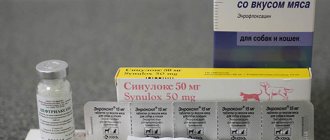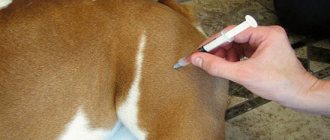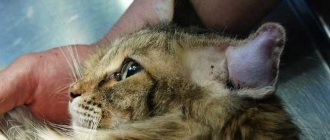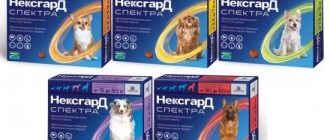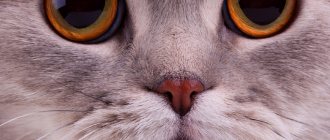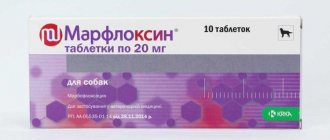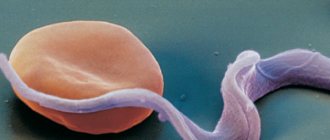Can cats take antibiotics? The answer is yes. There are cases of diseases when you cannot do without them. But before you make any gestures towards antibacterial therapy, you need to clearly know what antibiotics can be given to your cat.
It is not necessary to try to learn their name and purpose; it is enough to make friends with a veterinarian who will always help you choose the right drug, calculate the dosage and comment on possible methods of administration.
The information in the article is for informational purposes only and cannot be used for home self-medication of animals by a non-specialist!
Types of antibiotics
There are several different classifications of medications.
What are antibiotics and what are they?
By type of action
According to the mechanism of action, they are distinguished:
- bactericidal - destroying;
- bacteriostatic - locking.
Bactericidal drugs include drugs that destroy bacteria during exposure. These are quite strong agents, the use of which must be treated with caution. Example: With a staph infection, the killed bacteria can clog the urethra. However, in case of severe illnesses, bactericidal medications can save the life of a pet - their use is important in cases of sepsis, pyometra or other serious infection. This group also works well for local inflammation—the treatment of purulent wounds.
Antibiotics are prescribed to cats for the treatment of extensive wounds.
Bacteriostatic drugs act more gently, preventing the proliferation of bacteria, which eventually die on their own and are eliminated from the body.
According to the spectrum of action
Narrow-spectrum antibiotics are drugs that affect a specific type of pathogen. Broad-spectrum products destroy several types of bacteria at the same time.
By chemical composition
Like human drugs, all veterinary drugs are classified according to their chemical structure:
- penicillins;
- cephalosporins;
- tetracyclines;
- macrolides;
- chloramphenicol;
- aminoglycosides, etc.
More than 25 types of antibiotics are used in veterinary medicine.
By location of impact
Antibiotics are divided into local and general drugs. For each affected area, its own group of drugs has been developed:
- Ointments and sprays are used to treat skin lesions.
- Eye drops and ointments are the best remedy for treating bacterial conjunctivitis.
- For systemic infections, medications are prescribed in tablets or intramuscularly/intravenously.
- Aerosols have been developed for respiratory therapy.
- For the treatment of vaginitis, you can purchase suppositories.
Drops containing antibiotics are suitable for the treatment of ophthalmic diseases
Classification of antibiotics. Release forms
You shouldn’t try to remember all the possible commercial names of drugs that cats can use. It is always enough to ask which antibiotic or active substance is included in the antimicrobial drug.
According to their action, antibiotics are divided into:
- bacteriostatics (inhibit the ability of bacteria to reproduce and develop);
- bactericidal (kill pathogens).
According to the active substance:
- penicillins:
- cephalosporins:
- aminoglycosides:
- fluoroquinolones:
- nitrofurans:
- chloramphenicol:
- lincosamides:
- tetracyclines:
- macrolides:
- sulfonamides:
- glycopeptides:
- polymyxins:
- carbapenems:
According to the spectrum of action:
- wide spectrum;
- highly specific.
By method of administration to the body (how to give an antibiotic to a cat):
- oral (in the mouth);
- injection (in the form of injections);
- local (powders, ointments, gels, etc.).
By origin:
- natural (true) - chemical substances produced by some microorganisms to combat others;
- synthetic – artificially created antimicrobial agents.
The principle of action does not depend on the form of release of the medicine, the only question is the convenience of administration - for some it is convenient to inject, for others it is convenient to give the cat an antibiotic in tablets.
Why contact a veterinarian to prescribe antibiotic therapy?
It is very difficult to choose the right antibiotic and calculate the correct required dose yourself without consulting a veterinarian. Bacteria can adapt to conditions that are worse for them and get used to drugs. If the type of drug is chosen incorrectly, the bacteria may take on a different form that is resistant to this drug. In this case, it will be more difficult to defeat the disease.
In some cases, a sensitivity test is necessary to determine the effectiveness of a medication against a specific type of bacteria. Therefore, if the disease has become severe and cannot be treated without antibiotics, a visit to the veterinarian is most advisable.
Cats are tested to determine their sensitivity to specific antibiotics.
What diseases are antibiotics used to treat?
There are a huge number of diseases in animals, the successful treatment of which requires antibiotic therapy. Antibiotics are required for the treatment of the following diseases:
- cystitis, urethritis;
- ICD;
- pyelonephritis;
- bacterial gastritis;
- infectious diseases of the respiratory tract;
- pneumonia;
- tuberculosis;
- pyometra;
- giardiasis;
- infectious diseases of the eyes, ears;
- bacterial and purulent skin lesions;
- feline herpes.
Antibiotic therapy is mandatory after surgery (including sterilization), administered during catheterization of the bladder and during other interventions to exclude the occurrence of inflammatory processes. Antibiotics are prescribed after the necessary tests and studies have been carried out and a diagnosis has been made.
The dosage is selected taking into account the weight and age of the pet
Spectrum of action in veterinary medicine
Antibacterial agents are given in the presence of inflammatory processes in the cat’s body with the involvement of pathogenic or conditionally pathogenic microflora.
Antibiotics are widely used in veterinary medicine to treat diseases caused by pathogenic bacteria and fungi
List of indications:
- Dermatological infections accompanied by open wounds on the animal’s body
- Abscesses, cellulitis, open wounds with purulent exudate
- Urological problems
- Eye diseases - conjunctivitis, blepharitis, corneal ulcer, etc.
- Surgical interventions
- Ear diseases
- Severe infectious diseases. Relevant for unvaccinated cats
Pros and cons of antibiotics
Antibiotic therapy has its pros and cons. All these medications not only promote faster healing, but also cause harm to the caudate. You can minimize the negative consequences by selecting the most effective medication for a specific disease and correctly calculating the dose. In this case, all the advantages of this treatment method will appear:
- several doses of antibiotics will be enough to achieve the effect;
- the pet’s condition will quickly improve;
- the number of side effects is minimized;
- the antimicrobial effect will be effective even with a large number of microorganisms.
A properly selected antibiotic quickly restores the animal
However, when using antibiotic therapy, the disadvantages of this process must also be taken into account. The main negative effect of long-term treatment with this group of drugs is a decrease in the quadruped’s immunity. In addition, the following disadvantages of antibiotic therapy can be listed:
- possible addiction to the medication with a long course;
- an error in dose calculation can lead to extremely serious consequences;
- possible side effects in the form of allergic reactions and gastrointestinal disturbances;
- After treatment, it is necessary to restore the disturbed intestinal microflora.
Advantages and disadvantages for cats
The use of antibacterial agents allows the cat to quickly recover from an inflammatory infection, heal wounds and restore its former health.
At the same time, new generation antibiotics, which are used in veterinary medicine, have fewer contraindications and consequences than first generation drugs.
This means that the animal will recover more quickly from inflammatory processes.
Drugs in this group do not act selectively, but destroy all existing microflora in the body.
Thus, the animal can get dysbiosis.
When treating with antibiotics, it is very important to follow the correct dosage
Allergic reactions are not excluded. Therefore, the owner needs to carefully monitor their pets during the course of antibiotic therapy; if any side effects appear, the pet must be immediately shown to a veterinarian.
Commonly used antibiotics for cats
What medications are most often used?
- Amikacin is an effective drug prescribed for the treatment of infectious diseases caused by Salmonella, Klebsiella, and Escherichia coli. The medicine is injected into the muscle every 8 hours at 5-10 mg per kilogram of body weight. The drug is not prescribed if the cat has urolithiasis or suffers from kidney disease.
- Gentamicin 4% is a long-known aminoglycoside that is effective against gram-negative microbes. Intramuscular administration of gentamicin will help quickly cure pneumonia, peritonitis, arthrosis, and cope with colds. Injections are given 2 times a day at a rate of no more than 4.4 mg per kilogram of the pet’s weight. The course should not be longer than 5 days. Gentamicin is not prescribed to elderly and weakened cats suffering from nephrotic diseases. The antibiotic may cause hearing complications.
- Neomycin is an antibiotic with a broad spectrum of action, effective against almost all infectious diseases of the gastrointestinal tract and skin staphylococcal infections. Neomycin is available in different forms: as an ointment, as an injection for injection into a muscle, or as a powder (which must be dissolved in water) for drinking. Neomycin is administered 3 times a day for 3-7 days at a dose of 10 mg per kilogram of body weight.
- Amoxiclav is a mixture of amoxicillin and clavulanic acid. The highly effective product is available in the form of an injection solution and in tablets, which are given to pets in a quarter for every 5 kg of body weight, 2 times a day for a course of 10 days.
- Enrofloxacin (Baytril) is a fluoroquinolone and acts on any bacteria. The dosage of the injection solution is 0.5 ml per 5 kilograms of body weight. Treatment lasts from 5 to 10 days. The effect is observed within 30 minutes after the injection into the muscle.
- Ciprofloxacin is also a fluoroquinolone. It can be bought in the form of a solution for injections and tablets. The medication is effective against staphylococci, streptococci, enterobacteria, intestinal, pseudomonas, hemophilus influenzae, mycoplasma and chlamydia.
- Tetracycline can also cope with the treatment of many diseases, including diseases of the genitourinary system, pneumonia, etc. It is prescribed for herpes and conjunctivitis.
All these drugs must be purchased at a veterinary pharmacy.
Regular pet stores do not sell medicinal veterinary drugs.
Human medicines for treating animals
Many owners are interested in which human antibiotics are suitable for treating four-legged pets. As a rule, veterinarians do not recommend resorting to the use of such drugs and advise using them only in emergency cases.
The following human antibiotics can be used to treat pets:
- Flemoxin solutab. In emergency cases, this drug is used to treat open wounds and abscesses in cats. The dose of the drug is reduced by 2-3 times.
- Tetracycline eye ointments and drops. These products are suitable for treating inflammation of the eye mucosa in pets.
- Cephaloridine. This antibiotic belongs to the cephalosporins and is used mainly for problems with the gastrointestinal tract.
Antifungal drugs
It is traditionally believed that fungal diseases cannot be treated with antibiotics. On the contrary, long-term use of antibiotics causes mycoses. However, there are a number of antibiotics that are prescribed to treat fungal diseases in cats. These include:
- Nystatin, which in commonly used doses acts fungistatically (slowing down the growth of fungi), and in high concentrations - fungicidal (destroying fungi). Nystatin is especially effective against Candida fungi. Nystatin is used for candidiasis of the gastrointestinal tract, mucous membranes, and genitourinary organs. Nystatin is used topically as an ointment.
- Levorin is also used to combat candidiasis in the form of a 5% ointment or aqueous suspension, as well as orally.
- "Griseofulvin" is prescribed for trichophytosis and is given along with food.
Antibiotics are effective against fungal infections in cats
What drugs are used for infectious diseases
Antibiotics used for cats are divided into 2 types:
- bactericidal - their action is aimed at destroying bacteria;
- bacteriostatic - they prevent further growth of bacteria, but the course must be followed to the end, otherwise premature discontinuation of the drug may cause bacterial growth to resume again.
What antibiotics can be given to cats for infectious diseases is usually determined by a veterinarian after examining the animal, during which the general condition of the animal and the form of the disease will be assessed.
Most often in this case, Amoxicillin, Clindamycin, or Benzylpenicillin are used, since these substances have a minimal effect on the cat’s internal organs, that is, they do more good than harm, but only if they are used no more than twice.
Amoxicillin is used for infectious diseases
Quite often, cats develop cystitis of an infectious nature. Characteristic symptoms of the disease are frequent urination, apathetic state, and regurgitation of consumed food. In this case, the specialist prescribes an antibiotic exclusively in injections, because the tablets will not be absorbed properly due to vomiting.
Advice! Since the effect of antibiotics on the body is great, it is advised to protect your pet from pregnancy for two to three months after treatment.
Which antibiotic to choose?
When choosing a medication, it is advisable to determine the causative agent of the disease and its sensitivity to a specific drug. You immediately have to take into account other factors: the animal’s susceptibility, the characteristics of its metabolism depending on age and the presence of certain pathologies - renal/liver failure or diabetes mellitus.
For an unspecified diagnosis, broad-spectrum antibiotics are prescribed, which include penicillins, cephalosporins and fluoroquinolones.
If the diagnosis is not in doubt, preference is given to narrow drugs. It is advisable to use one drug as monotherapy. Complex use of antimicrobial agents is prescribed if:
- mixed type infection;
- severe infection requires immediate treatment even before diagnosis to expand the spectrum of exposure;
- you need to enhance the effect of one antibiotic with another;
- as a result of a combination of drugs, their toxic effect is reduced by prescribing smaller doses of each medication;
- if monotherapy was ineffective.
Monotherapy with antibiotics is considered more gentle for cats
The duration of antibiotic therapy depends on the virulence of the pathogen, the duration of the disease, and the danger to the pet. In acute forms, the course is shorter. After the symptoms disappear, therapy continues for another 2-3 days. Stop the medicine immediately.
Rules of application
Only a veterinarian should select the medicine and dosage to treat a cat. If the dose is too small, the infection will take hold in the body, even if the pet’s condition has returned to normal.
Only a veterinarian should select the medicine and dosage for treating a cat.
Exceeding the required dose can cause intoxication and even death of the animal due to the toxic effects of antibacterial drugs.
It is important not to use the medicine after its expiration date.
The drug should be purchased only from licensed pharmacies that specialize in veterinary medicines.
If the doctor prescribed the drug by injection, he must administer the first one in the clinic.
This will allow you to evaluate the reaction of the cat’s body to a foreign substance, and in case of individual intolerance, take action and prescribe another antibiotic.
It is important not to use the medicine after its expiration date
The remaining injections can be given at home according to the schedule prescribed by the veterinarian.
The least sensitive place for a puncture in a cat is the withers. The skin on it should be squeezed, insert the needle there so that it is inside and not out, and quickly inject the solution. There is no need to treat the puncture area with alcohol.
If the cat is prescribed the drug in tablet form, it is placed deeper on the tongue or crushed with food. If you need to give the tablet to a kitten, it is recommended to first divide it into parts.
It is important not to stop treatment after symptoms disappear, but to complete the full course of antibiotic therapy.
Otherwise, the pathogenic microflora will not be completely eliminated, but will go into a dormant form and become resistant to this product.
Be sure to read:
Kvamatel for cats: instructions, indications, dosage, analogues and reviews
Antibiotics usually last 1-3 weeks.
The course of treatment for some dermatological infections can last 2-3 months and interrupting it is contraindicated.
What human antibiotics can be used for cats?
The use of human medicinal drugs for cats is not recommended because it is very difficult to calculate the dosage of the active substance. However, in some cases, when the veterinary pharmacy is far away, it is better to use human antibiotics than to abandon a sick animal to its fate. For treatment, you can take the medications listed below (dosage is calculated per kilogram of animal weight).
- The penicillin group is used to treat sepsis, pleurisy, purulent inflammation of the skin, purulent peritonitis, respiratory tract infections, endometritis in all locations. Before use, add 2-4 ml of sodium chloride into the bottle:
- benzylpenicillin novocaine salt is administered intramuscularly at 30,000-40,000 units per kilogram of weight;
- benzylpenicillin sodium and potassium salts (penvetin in veterinary medicine) are administered intramuscularly every 6 hours at 10,000-20,000 units per kilogram of weight;
- ampicillin sodium salt - intramuscularly every 6-8 hours at a dosage of 15-30 mg per kilogram of body weight;
- bicillin 5 (used for the treatment of chronic forms of the disease after exacerbations) - intramuscularly once every 2 weeks, 40,000-60,000 units per kilogram of weight;
- Antibiotics of the tetracycline group are necessary for the treatment of inflammatory diseases of the respiratory system and gastrointestinal tract. Medicines are given orally (by mouth) at the rate of 20-25 mg per kilogram of weight, 2 times a day;
- tetracycline eye ointments are placed under the eyelid for inflammation of the eye mucosa 2 times a day. Tetracycline eye drops are instilled 1-2 drops 3 times a day;
- The cephalosporin group is used mainly for sepsis, respiratory diseases and gastrointestinal diseases. Cephaloridine and cephalothin are administered intramuscularly 3 times a day, 5-10 mg per kilogram of body weight (due to pain, the medicine is diluted with novocaine).
Some human medications are suitable for cats
What is treated with antibiotics
Antibiotics and antimicrobials are indicated for bacterial infections and some types of fungal diseases. This group of drugs does not act on viruses.
In what cases are antibiotics prescribed:
- colds complicated by pneumonia, sore throat or bronchitis, upper respiratory tract infections (rhinitis);
- purulent inflammation of the kidneys (pyelonephritis);
- bacterial inflammation of the urinary system (urethritis, cystitis - also used for catheterization);
- purulent conjunctivitis and otitis;
- pseudomonosis;
- intestinal infections;
- abscesses, deep purulent wound processes;
- leptospirosis;
- chlamydia;
- staphylococcosis;
- bacterial (purulent) inflammation of the skin;
- oncology (to reduce infection of affected tissues by secondary infection);
- elevated body temperature (treatment or prevention of secondary infections in viral diseases);
- postoperative support (for example, antibiotics after sterilization of a cat).
Side effects
Both people and animals can develop negative reactions to any medication. The body may react to the first entry of the active substance into the body, or negative phenomena may develop during a long course of treatment. The most common ways a cat may respond to antibiotic therapy are:
- diarrhea;
- allergic reaction - itching of the skin, rashes, hives.
An allergy to antibiotics in cats can cause severe itching.
In particularly difficult cases, the animal may develop swelling, seizures, and liver damage. After a long course of antibiotics, a cat may develop a fungal disease.
How to reduce side effects?
After a long course of antibiotics, an animal, like a person, can develop dysbiosis. To avoid unpleasant phenomena, it is recommended to take probiotics during and after antibiotic therapy. They should be given 2 hours after the tablets or after the injection once a day, preferably in the evening. The course should continue for two weeks after the last dose of the medicine.
The most effective drugs are “Bifitrilak”, “Enterol”, “Zoonorm”, “Subtilis”, “Viyo”.
Nutritional drink for cats
For dermatological reactions, which usually indicate the development of an allergy, it is recommended that the cat be given an antihistamine and discontinue treatment with this drug. In cats, the development of allergies may be indicated by pharyngitis in the absence of inflammation of the tonsils.
The reaction may manifest itself as enlarged lymph nodes. In case of allergic reactions, taking Diphenhydramine, Suprastin, Tavegil is indicated, and in especially severe cases, corticosteroids (Hydrocortisone, Prednisolone). If after treatment the cat develops candidiasis (usually in the mouth), antifungal agents are prescribed.
What are the dangers of unauthorized prescription of antibiotics?
It is very difficult for a cat owner to calculate the correct dose of antibiotic on his own. If the drug group is selected incorrectly, the cat may become accustomed to this group. In case of overdose, when the medication is used for a long time at the maximum dose or with a single overestimation of the dose, as well as when the pet develops individual intolerance, a toxic reaction may develop.
Table. Complications that arise when doses of different groups of antibiotics are exceeded
| Antibiotic groups | Complications |
| Penicillins | Neuro-, nephrotoxic reaction |
| Cephalosporins | Neuro-, nephrotoxic reaction |
| Tetracyclines | Gastrointestinal complications: loss of appetite, vomiting, diarrhea |
| Macrolides | Gastrointestinal complications: loss of appetite, vomiting, diarrhea |
| Aminoglycosides | neurotoxic effect - decreased blood pressure, respiratory depression, hearing impairment |
| Sulfonamides | Lesions of the hematopoietic system |
An overdose of antibiotics causes severe reactions in the body
Does a cat need antibiotics for wounds?
For boils, inflamed wounds, and purulent skin infections, tetracycline ointment is prescribed.
When a cat has purulent wounds, it is almost always necessary to resort to antibiotics.
If there is a risk of infection, a prophylactic course of amoxicillin is administered.
When a cat has purulent wounds, it is almost always necessary to resort to antibiotics. Otherwise, the infection can spread throughout the body and cause a deadly disease - sepsis.
Such wounds are easy to identify, since pus is released from them, the hair at the site of injury is stuck together and emits a putrid odor. An increase in body temperature may also indicate that the process of suppuration has started.
How to give antibiotic tablets to a cat?
If the veterinarian prescribed the pet to take medication in tablets, the cat owner will have to learn a new skill for him - how to give the tablet to the cat. Some tailed animals will happily eat the medicine, crushed and added to a small amount of their favorite treat (favorite wet food, for example, a piece of butter, etc.). You can roll the tablet into a bread crumb or a piece of cheese. However, there is always a danger that your pet will chew the lump and spit out the medicine.
Video - Giving the cat a pill
At a veterinary pharmacy you can buy a good inexpensive device called a tablet dispenser. The tablet is attached to the end of a syringe-like device and inserted deep into the pet's mouth at the back of the tongue so that he cannot spit it out. After this, you need to cover your pet’s mouth and nose so that he makes a swallowing movement. You can simply master the skill and throw the tablet also deep into the root of the tongue.
Basic rules for using drugs
Antibiotic therapy is prescribed only in extreme cases, when the use of such drugs cannot be avoided. Depending on the disease identified in the pet during the examination, the specialist prescribes pills or a course of injections.
Each antibacterial agent is accompanied by instructions for use, which indicate the duration of taking the drug. As a rule, the course lasts at least 5 days and, if necessary, can be extended to 7 or 14 days. Some long-acting antibiotics need to be taken for no more than 3 days, while for others just 1 injection is enough. But in any case, you need to consult a specialist before starting treatment.
Independently reducing the duration of medication use can lead to the fact that the cat’s condition will significantly worsen and you will have to resort to using stronger drugs.
Injecting antibiotics intravenously at home is not recommended, since this procedure requires certain skills. It is also advisable to give intramuscular injections in a veterinary hospital, but if necessary, the owner can give the injection himself. The procedure should be carried out as follows:
- Secure the pet in your arms so that it does not escape during the administration of the solution.
- Take a suitable syringe. If you need to inject no more than one cube, then an insulin syringe will do. It is recommended to draw a solution with an oily consistency into a regular syringe with a medium needle.
- Draw the medicine into the syringe. It is desirable that the solution be at room temperature.
- Insert the needle into the pet's thigh, immersing it 1 cm.
- Calm the cat and give her a treat.
Tablets can be given to a cat at home using a special device sold in veterinary pharmacies. The owner is recommended to act as follows:
- Attach the tablet to the end of the device.
- Insert it deep into the cat's mouth at the root of the tongue.
- Cover the cat's mouth and nose to provoke its swallowing reflex.
You can give the tablet without using a special device, by carefully opening your pet’s mouth and placing it on the root of the tongue. If the animal refuses to take the medicine, then you can add it to the cat’s food. In this case, it is not advisable to crush the tablets.
How to administer an antibiotic intramuscularly?
You need to inject medications using a new syringe each time. The cat needs to be secured with the elbow of your free hand so that it does not jerk when the medicine is administered - some antibiotics are very painful. There is no need to lubricate the injection site with alcohol.
The drug in the syringe must be warmed by hand to at least room temperature. There is no need to inject the solution directly from the refrigerator. The selection of needles is carried out in accordance with the volume and viscosity of the medication. If the medicine is administered no more than one cube and the solution is of aqueous consistency, you can take an insulin syringe. If the antibiotic is of the oily type, you will need a regular syringe with a medium needle.
Can a cat treat a wound with iodine?
It is contraindicated to treat a purulent wound with iodine and brilliant green. If it does not fester, you can lubricate its edges with iodine without getting deep into the damage.
Before applying the medicine, it is necessary to clean the damaged area from hair and dirt. Dried pus can be softened using hydrogen peroxide (up to 3%), and the fur must be carefully cut off with scissors.
suitable for cleaning the injured surface .
